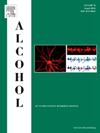KCa2 channel positive modulation reduces alcohol drinking in female C57BL/6J mice
IF 2.9
4区 医学
Q3 PHARMACOLOGY & PHARMACY
引用次数: 0
Abstract
Although men have historically exhibited higher levels of alcohol use disorder (AUD) diagnosis, the gap between men and women has been diminishing quickly. Preclinical screening for pharmacological treatments for AUD has typically focused solely on males, ignoring the possibility that males and females may differ mechanistically for the same behavioral phenotype. To ensure the efficacy of treatment targets across the sexes, it is crucial to study the pharmacological effects of AUD treatments in males and females. While positive KCa2 channel modulation can reduce ethanol consumption and seeking behaviors, withdrawal-induced hyperexcitability, and negative affective behaviors in male rodents, the effect of KCa2 channel modulation on female ethanol consumption has not been reported. To determine the efficacy of KCa2 channel positive modulation in female C57BL/6J mice, we assessed the ability of the KCa2 channel positive modulator 1-EBIO to affect locomotor activity, voluntary home cage ethanol intake prior to and following chronic intermittent ethanol (CIE) exposure, and voluntary home cage sucrose drinking. There were no significant changes to distance traveled in an open field apparatus following administration of 1-EBIO in our locomotor assay. In ethanol drinking mice, 1-EBIO significantly reduced ethanol consumption in air controls and CIE exposed mice, without altering water consumption. While administration of 1-EBIO did not affect consumption of sucrose in male mice, 1-EBIO significantly increased sucrose intake in females. Together, these data provide further evidence that KCa2 channel positive modulation is a promising therapeutic target to reduce ethanol drinking in males and females alike.
KCa2通道正向调节减少雌性C57BL/6J小鼠的饮酒。
尽管男性在历史上表现出更高的酒精使用障碍(AUD)诊断水平,但男性和女性之间的差距正在迅速缩小。AUD的临床前药物治疗筛查通常只针对男性,而忽略了男性和女性在相同行为表型下可能存在机制差异的可能性。为了确保治疗靶点在性别上的有效性,研究AUD治疗在男性和女性中的药理作用至关重要。虽然正向的KCa2通道调节可以减少雄性啮齿动物的乙醇消耗和寻找行为、戒断诱导的超兴奋性和负面情感行为,但KCa2通道调节对雌性乙醇消耗的影响尚未报道。为了确定雌性C57BL/6J小鼠KCa2通道正向调节的功效,我们评估了KCa2通道正向调节剂1-EBIO对运动活动、慢性间歇性乙醇暴露(CIE)之前和之后自愿在家笼中乙醇摄入以及自愿在家笼中蔗糖饮用的影响。在我们的运动试验中,使用1-EBIO后,在开放场地装置中行走的距离没有明显变化。在饮用乙醇的小鼠中,1-EBIO显著减少了空气对照组和CIE暴露小鼠的乙醇消耗,而不改变水消耗。虽然给药1-EBIO不影响雄性小鼠的蔗糖摄入量,但1-EBIO显著增加了雌性小鼠的蔗糖摄入量。总之,这些数据提供了进一步的证据,证明KCa2通道正调节是一个有希望的治疗靶点,以减少男性和女性的乙醇饮酒。
本文章由计算机程序翻译,如有差异,请以英文原文为准。
求助全文
约1分钟内获得全文
求助全文
来源期刊

Alcohol
医学-毒理学
CiteScore
4.60
自引率
4.30%
发文量
74
审稿时长
15.6 weeks
期刊介绍:
Alcohol is an international, peer-reviewed journal that is devoted to publishing multi-disciplinary biomedical research on all aspects of the actions or effects of alcohol on the nervous system or on other organ systems. Emphasis is given to studies into the causes and consequences of alcohol abuse and alcoholism, and biomedical aspects of diagnosis, etiology, treatment or prevention of alcohol-related health effects.
Intended for both research scientists and practicing clinicians, the journal publishes original research on the neurobiological, neurobehavioral, and pathophysiological processes associated with alcohol drinking, alcohol abuse, alcohol-seeking behavior, tolerance, dependence, withdrawal, protracted abstinence, and relapse. In addition, the journal reports studies on the effects alcohol on brain mechanisms of neuroplasticity over the life span, biological factors associated with adolescent alcohol abuse, pharmacotherapeutic strategies in the treatment of alcoholism, biological and biochemical markers of alcohol abuse and alcoholism, pathological effects of uncontrolled drinking, biomedical and molecular factors in the effects on liver, immune system, and other organ systems, and biomedical aspects of fetal alcohol spectrum disorder including mechanisms of damage, diagnosis and early detection, treatment, and prevention. Articles are published from all levels of biomedical inquiry, including the following: molecular and cellular studies of alcohol''s actions in vitro and in vivo; animal model studies of genetic, pharmacological, behavioral, developmental or pathophysiological aspects of alcohol; human studies of genetic, behavioral, cognitive, neuroimaging, or pathological aspects of alcohol drinking; clinical studies of diagnosis (including dual diagnosis), treatment, prevention, and epidemiology. The journal will publish 9 issues per year; the accepted abbreviation for Alcohol for bibliographic citation is Alcohol.
 求助内容:
求助内容: 应助结果提醒方式:
应助结果提醒方式:


